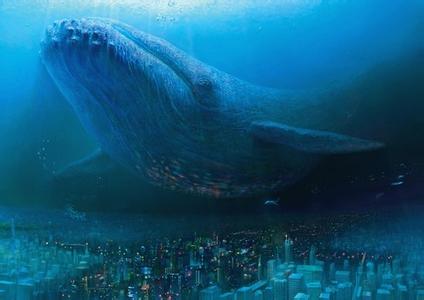The largest animal on Earth is thriving anew, at least off of California. And all it took was for people to stop hunting blue whales.That's according to a new study in Marine Mammal Science.
據(jù)《海洋哺乳動物學(xué)》雜志報道:地球上最大的動物正重新崛起,至少,在美國加州是這樣的。而要實(shí)現(xiàn)這一目標(biāo),只需停止獵殺藍(lán)鯨。
Today, the California group of the mighty blue whales numbers roughly 2,200, according to conservationists and based on distinctive singing. That compares with the more than 3,000 killed over the first seven decades of the 20th century. The blue whale can grow up to 30 meters in length and weigh more than 180 metric tons—and requires for food each day roughly 40 million tiny sea creatures called krill.
據(jù)自然資源保護(hù)論者及藍(lán)鯨獨(dú)特的叫聲可知,如今美國加州巨形藍(lán)鯨的種群數(shù)量約為2,200個。相比之下,20世紀(jì)前70年間,逾3,000頭藍(lán)鯨被殺。藍(lán)鯨能一直長到30米長、180多公斤——它們每天以4000萬條磷蝦為食。

This may explain why the number of whales off California has stopped growing. Some conservationists had argued that individuals being hit and killed by ship traffic held back population growth. But the new research suggests it's more likely that California blue whales have reached the limits to growth in that region of the eastern Pacific Ocean.
這也許能解釋為什么那些離開加州的藍(lán)鯨沒能繼續(xù)繁衍生息,增大自身種群。一些自然資源保護(hù)論者曾持這樣的觀點(diǎn):藍(lán)鯨數(shù)量之所以沒有增長,是因?yàn)樵馐艿胶I洗坏淖矒艉瞳C人們的捕殺。但新的研究認(rèn)為:更有可能的原因是它們的數(shù)量已經(jīng)達(dá)到了該物種在東太平洋環(huán)境容納量的最大值。
Of course, more than 350,000 blue whales were killed in other parts of the world in the 20th century. So the species has hardly recovered to its historical abundance. But, at least in California, the blue whale is back.
當(dāng)然,20世紀(jì),除加州外,還有350,000多頭藍(lán)鯨遭受獵殺。因此,藍(lán)鯨數(shù)量幾乎沒能恢復(fù)到原來那種繁榮昌盛的局面。但至少在加州,藍(lán)鯨數(shù)量又開始增加了。












